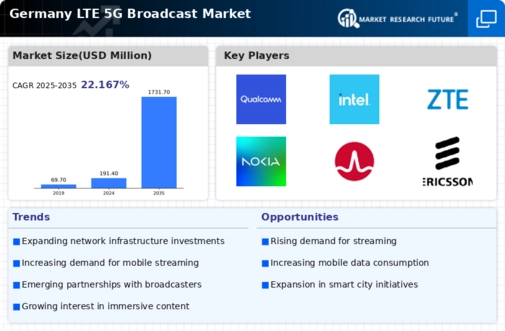Regulatory Framework Enhancements
The evolving regulatory framework in Germany is a crucial driver for the lte 5g-broadcast market. The government has been actively promoting policies that facilitate the deployment of 5G infrastructure, which is essential for the growth of broadcasting services. Recent initiatives aimed at streamlining the licensing process and reducing bureaucratic hurdles are likely to accelerate the rollout of 5G networks. The lte 5g-broadcast market stands to gain from these regulatory enhancements, as they create a more conducive environment for investment and innovation. Furthermore, the German Federal Network Agency has indicated plans to allocate additional spectrum for 5G broadcasting, which could potentially increase market opportunities. This supportive regulatory landscape is expected to foster competition among service providers, ultimately benefiting consumers through improved service offerings and pricing.
Advancements in Broadcast Technology
Technological advancements in broadcasting are significantly influencing the lte 5g-broadcast market. Innovations such as Multi-User Multiple Input Multiple Output (MU-MIMO) and beamforming are enhancing the efficiency and capacity of broadcast networks. In Germany, the integration of these technologies is expected to improve signal quality and coverage, thereby attracting more users to 5G broadcasting services. The lte 5g-broadcast market is witnessing a shift towards more sophisticated broadcasting solutions that can cater to the growing needs of consumers. As a result, investments in research and development are on the rise, with companies allocating substantial budgets to enhance their technological capabilities. This focus on innovation is anticipated to drive market growth, with estimates indicating a potential increase in market size by €1 billion by 2027, reflecting the industry's commitment to staying at the forefront of technological advancements.
Consumer Shift Towards Mobile Services
The shift in consumer behavior towards mobile services is a notable driver for the lte 5g-broadcast market. In Germany, an increasing number of users are opting for mobile platforms for their media consumption, driven by the convenience and accessibility of mobile devices. This trend is reflected in the rising number of mobile subscriptions, which reached over 100 million in 2025. The lte 5g-broadcast market is well-positioned to capitalize on this shift, as it offers solutions tailored to mobile users, including live streaming and on-demand content. As consumers continue to prioritize mobile services, the demand for efficient broadcasting solutions is expected to grow. This consumer behavior shift may lead to a market expansion, with projections indicating a potential increase in user adoption rates by 30% within the next two years, further solidifying the market's relevance in the telecommunications sector.
Increased Investment in Infrastructure
Investment in telecommunications infrastructure is a significant driver for the lte 5g-broadcast market. In Germany, both public and private sectors are recognizing the importance of robust infrastructure to support the growing demand for high-speed data services. The government has committed to investing €2 billion in expanding 5G networks, which will enhance the capabilities of the lte 5g-broadcast market. This influx of capital is likely to facilitate the deployment of advanced broadcasting technologies and improve network reliability. Additionally, partnerships between telecom operators and technology providers are emerging, aimed at optimizing infrastructure development. As these investments materialize, the market is expected to experience accelerated growth, with forecasts suggesting a compound annual growth rate (CAGR) of 20% over the next five years, driven by enhanced infrastructure capabilities.
Growing Demand for High-Quality Streaming
The increasing consumer demand for high-quality streaming services is a pivotal driver for the lte 5g-broadcast market. In Germany, the proliferation of smart devices and high-definition content has led to a surge in data consumption. Reports indicate that video streaming accounts for over 80% of mobile data traffic, necessitating robust broadcasting solutions. The lte 5g-broadcast market is poised to benefit from this trend, as it offers enhanced bandwidth and lower latency, enabling seamless streaming experiences. As consumers continue to seek superior quality in their media consumption, the market is likely to expand, with projections suggesting a growth rate of approximately 25% annually in the coming years. This demand for high-quality content delivery is expected to drive investments in infrastructure and technology, further solidifying the market's position in the telecommunications landscape.



















Leave a Comment